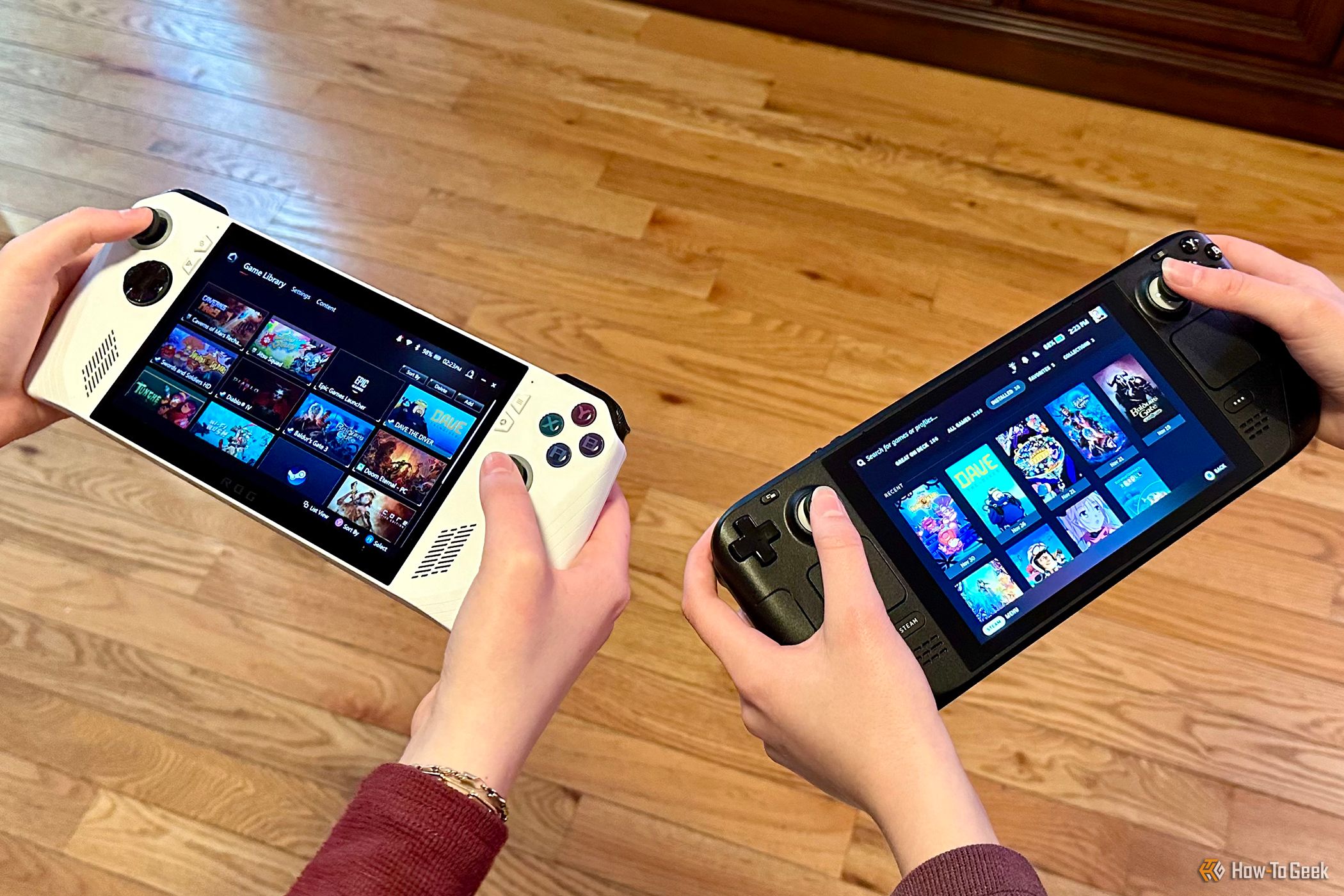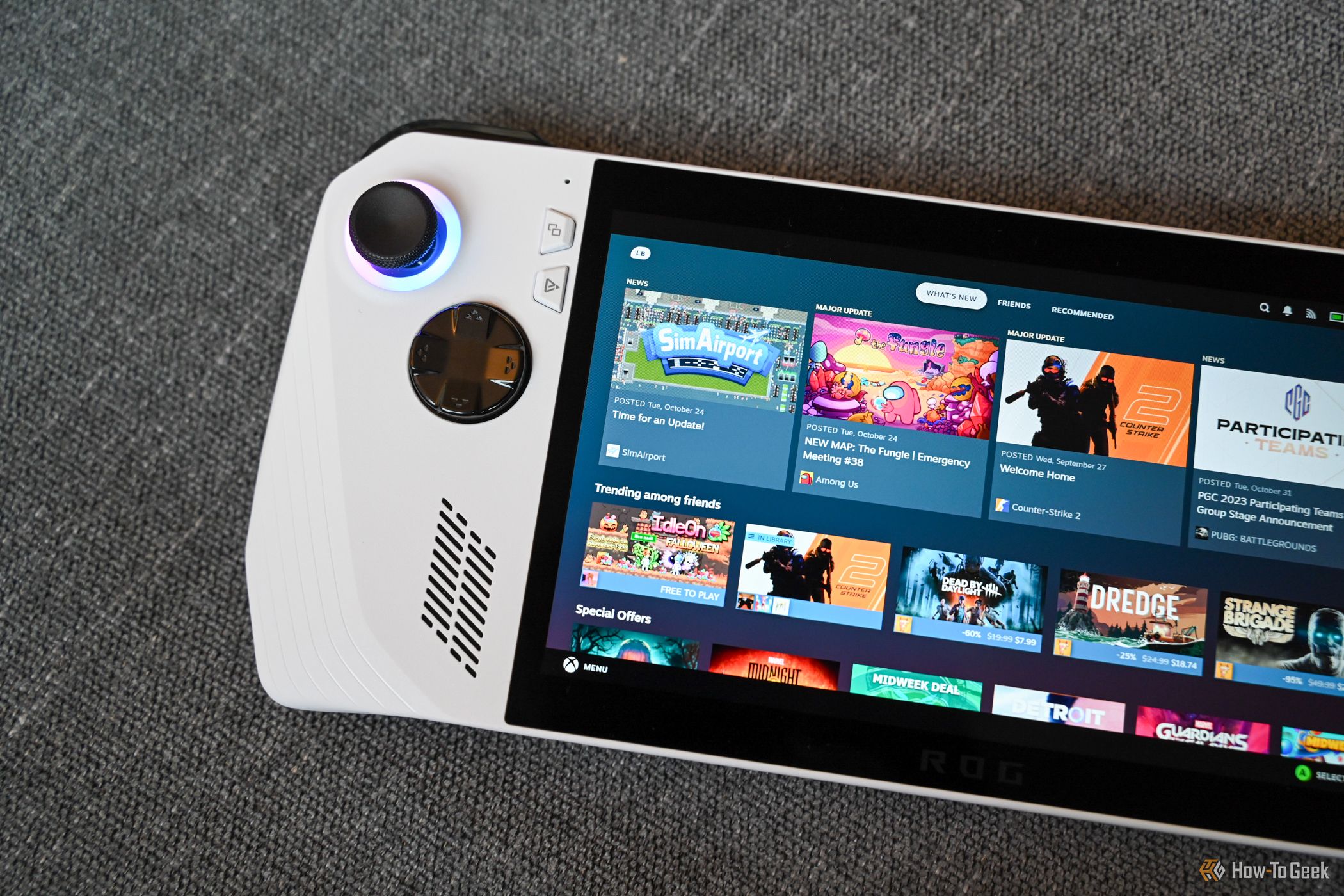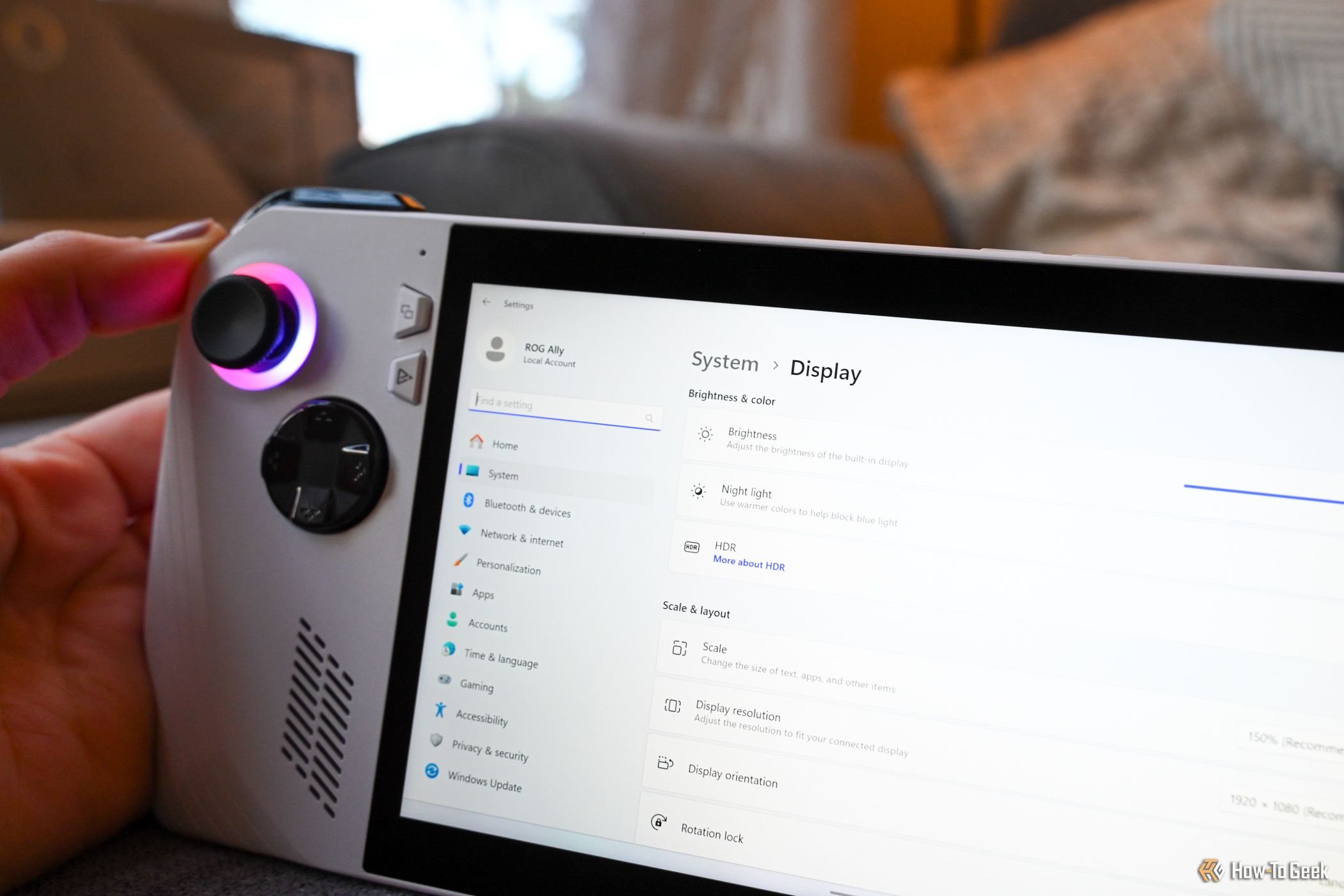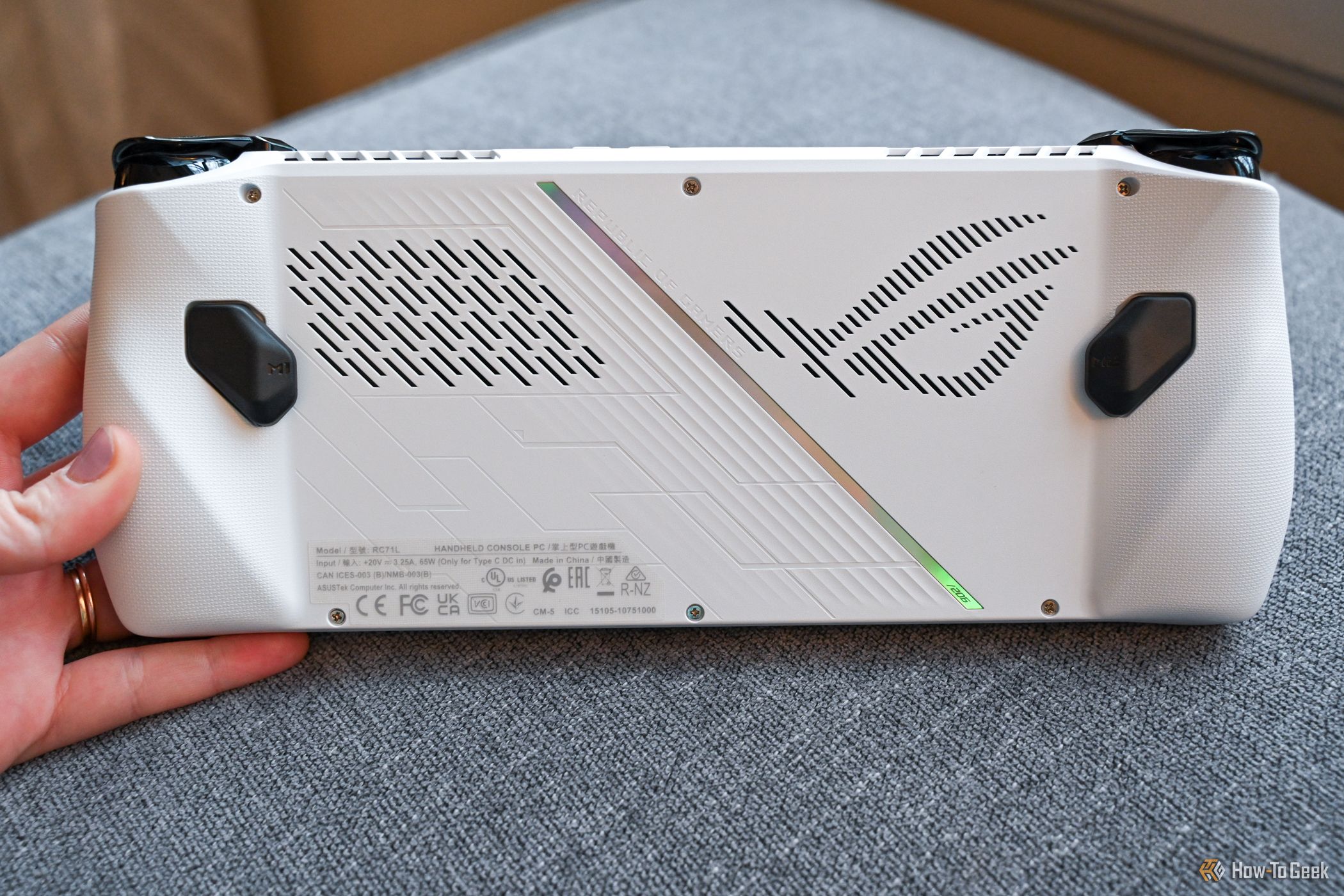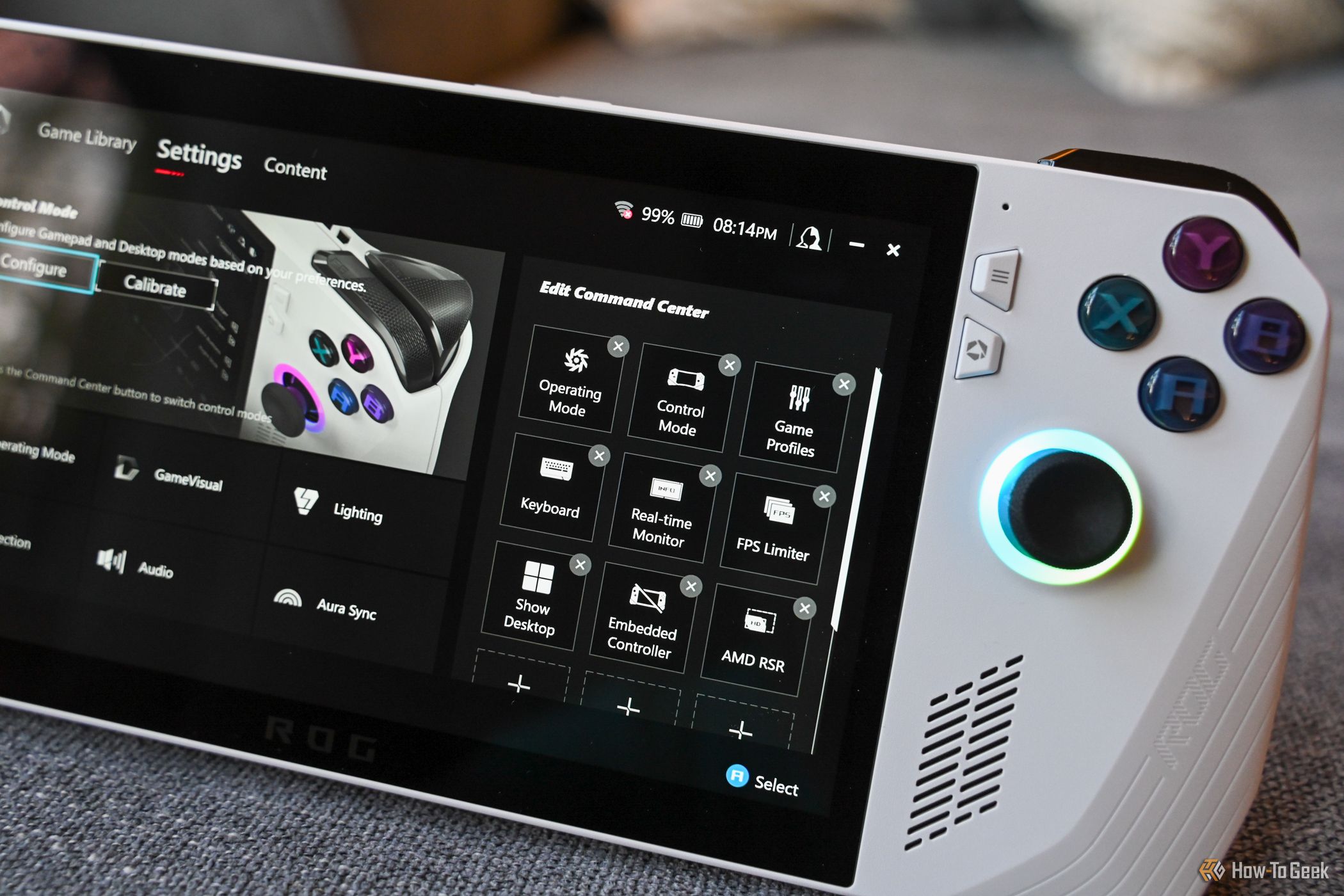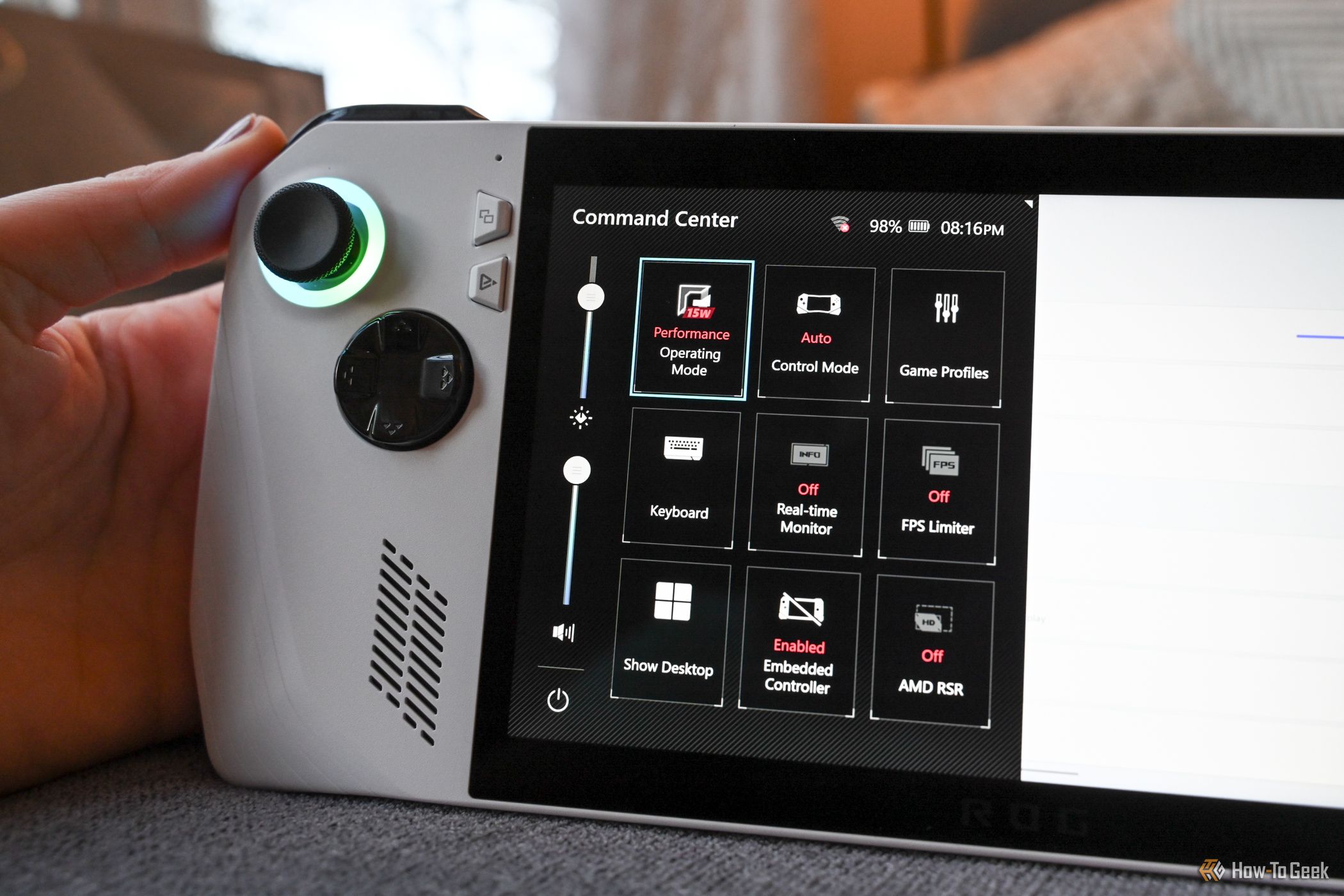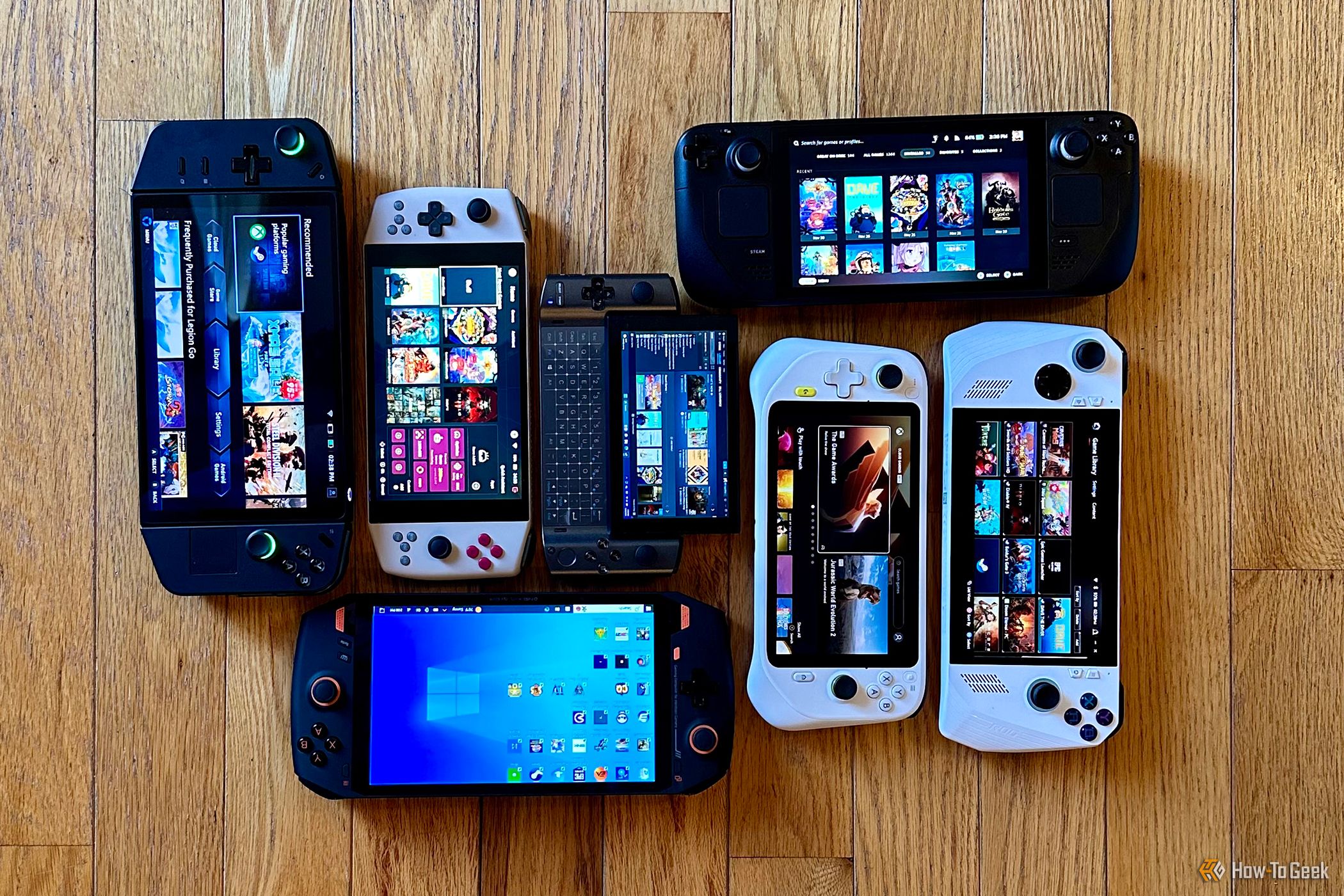Key Takeaways
- Steam Deck is the better choice in terms of model selection and price compared to ROG Ally, but it doesn't perform as well with more demanding games.
- Steam Deck has superior screen quality with the OLED display version, but the ROG Ally still holds its own with excellent color reproduction and higher resolution, as well as better speakers.
- ROG Ally is more versatile than Steam Deck but loses out in ease-of-use.
With over 130 million units and 1.1 billion apps sold to date since early 2017, the ubiquitous Nintendo Switch platform is a force to be reckoned with. It's no surprise then that by 2021, several smaller companies like GPD, AYANEO, and ONEXPLAYER began to explore the possibilities of a handheld gaming market on the PC side with powerful, but somewhat clunky and expensive, devices.
In February of 2022, Valve released the Steam Deck, which paired relatively low-cost devices with the might of the most popular PC digital software distribution platform. With millions of units sold, the Steam Deck is the most formidable presence in PC gaming handhelds. With that kind of success, it was only a matter of time before other companies began to take notice, the most prominent to date being ASUS with the ROG Ally, which was released in mid-2023, and quickly established itself as a viable alternative to Valve's market-leading product.
With a new contender to the throne, Lenovo's Legion Go, seeing release in November 2023 and experiencing some inevitable early growing pains, it's a good time to compare the two more established leaders in the segment, both of which have received a continuous series of updates, and see which is arguably the best choice and why.
The Asus ROG Ally, at least in its Z1 Extreme form, is a powerful handheld with great versatility but has a relatively high price. Valve's Steam Deck on the other hand, at least in its original 512GB LCD version, is a budget-friendly, and more streamlined, experience, albeit one with more limitations. Determining which is best, and whether other models in each of the series are a better choice, ultimately comes down to personal preference, but I'll still offer as objective a look as possible at the pluses and minuses of each platform, and, more dramatically, declare a winner.
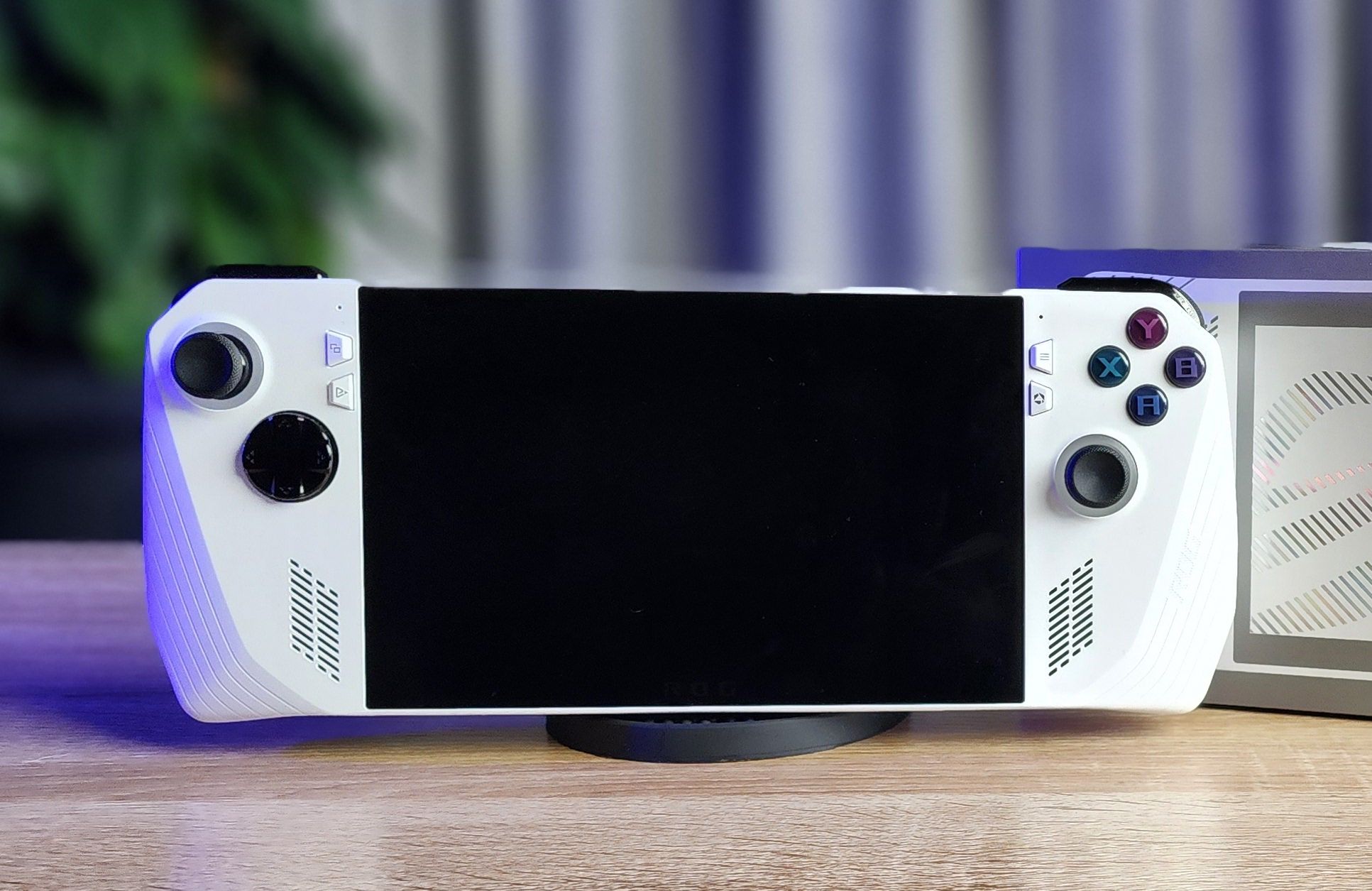
ASUS ROG Ally
The ASUS ROG Ally is the most powerful handheld gaming PC to date, and offers a fantastic gaming experience and access to the massive PC gaming library, but it's let down by dismal battery life and serious concerns about thermal design and hardware issues.
- Dimensions
- 28.0 x 11.1 x 2.12 ~ 3.24 cm (11.02" x 4.37" x 0.83" ~ 1.28")
- Number of Games Included
- 1 + Game Pass Ultimate Voucher
- Playing Time
- 45 mins to 3 hours (tested)
- Brand
- ASUS
- Weight
- 608g (1,34lbs)
- Chipset
- AMD Ryzen™ Z1 Extreme APU
- RAM
- 16GB LPDDR5
- Storage
- 512GB PCIe® 4.0 NVMe™ SSD
- Wireless Connectivity
- Wi-Fi 6E(802.11ax) (Triple band) 2*2 + Bluetooth® 5.2
- Display
- 7-inch, FHD (1920 x 1080) 16:9, 120Hz, IPS
- Output resolution
- 1920x1080
- Graphics
- AMD Radeon™ Graphics (AMD RDNA™ 3, 12 CUs, up to 2.7 GHz, up to 8.6 Teraflops)
- Ports
- ROG XG Mobile Interface and USB Type-C combo port, 3.5mm Combo Audio Jack, UHS-II microSD card reader
- Battery
- 40WHrs
Specifications and Prices Compared
The ROG Ally is available in two different models, one with an AMD Ryzen Z1 Extreme processor that retails for $699.99 and one with an AMD Ryzen Z1 processor that retails for $599.99, although both can often be found for much less through deals. The two models are identical, save for the aforementioned processor, with the Z1 Extreme featuring eight Zen 4 CPU cores and Z1 featuring six Zen 4 CPU cores, and the GPU, with the Z1 Extreme featuring 12 RDNA 3 cores and the Z1 four RDNA 3 cores. While the two extra CPU cores are not a huge differentiator, the extra GPU cores are, creating a roughly 30% performance gap. With the Z1, you do get an average of 20 minutes or so of extra battery life, but the trade-off in performance makes the Z1 Extreme the easy choice between the two despite the higher cost.
The Steam Deck has far more models available, with the key differences being storage, screen type, battery, and Wi-Fi speeds. While supplies last, Valve is still selling the original LCD-based Steam Decks starting at $349.00, but that only gets you the model with the 64GB eMMC SSD. While you can use the microSD card slot to expand storage, some games perform badly when run from a microSD card and some refuse to run at all, relegating their best usage to emulation, low-end gaming, or non-gaming usage. Of course, it's relatively easy to upgrade the SSDs in both the Steam Deck and ROG Ally, but that's still an extra cost, effort, and risk, no matter how small.
It's also important to point out that the ROG Ally vents some of its heat near its microSD card slot, which has been known to cause microSD cards to fail. ASUS just started to install copper heat shields over the microSD card slot to eliminate this issue, but there may still be handhelds in circulation without the fix, requiring warranty intervention.
The 256GB LCD Steam Deck is just $50.00 more than the 64GB eMMC SSD model, and far more practical, but still not as good as the $449.00 512GB LCD model, which also has premium anti-glare etched glass. Considering a modern game like Call of Duty: Modern Warfare 3 can use up to around 213GB of storage space, it's no wonder that most other handhelds, including the ROG Ally, come with at least 512GB as standard.
Finally, there are the two newest Steam Decks, both with spectacular 7.4-inch OLED displays versus the 7-inch of the older LCD models. The 512GB OLED is $549.00, while the 1TB OLED, which also features premium anti-glare etched glass and a fancier carrying case, is $649.00. The brighter OLED display is capable of richer HDR colors and has a maximum refresh rate of 90Hz versus the LCD's 60Hz. The OLED has other improvements as well, including Wi-Fi 6E and Bluetooth 5.3, rather than Wi-Fi 5 and Bluetooth 5.0, and a 50-watt-hour battery versus 40 watt-hour, gaining at least one hour more of battery life when performing the same activity, and sometimes a lot more. While Valve has done a good job of improving the Steam Deck LCD's display properties through software updates and menu options, there's no question that the OLED has the superior screen, and in fact, the best-looking screen of any PC gaming handheld to date.
Specifications and Price Winner: Steam Deck
Thanks to its range of options, lower regular retail price, and overall performance parity between its different models, the Steam Deck edges out the ROG Ally on Specifications and Price.
Screen Quality and Sound Compared
Despite its lack of OLED technology, the ROG Ally's display is no slouch. It's a 7-inch 120HZ IPS LCD with a 1000:1 contrast ratio and 100% sRGB color gamut with a 7ms response time and support for AMD FreeSync Premium. The resolution of the ROG Ally's 16:9 aspect ratio display is 1,920 x 1,080 versus the Steam Deck's 16:10 aspect ratio and 1,280 x 800 resolution. Before the Steam Deck OLED, the ROG Ally was arguably the best PC gaming handheld display out there, and thanks to its excellent color reproduction, fast response time, vibrance, and higher resolution, it can still hold its own.
In a nice gesture to Steam Deck LCD owners, Valve has enabled additional display options under Settings. Color vibrance can be set to Native, SRGB, or Boosted, and color temperature can go from a very yellow 4,000K up to a very white 11,000K. I found the sweet spot to be SRGB, which provides a nice pop of color without the oversaturation of Boosted, with a more balanced color temperature of 7,500K. It's still no match for the ROG Ally's untweaked display and absolutely no substitute for the brilliance of OLED, but these options make the Steam Deck LCD screen far more enjoyable to use than when it was first released.
Nintendo hit upon a good 7-inch screen size with the Switch, and both Valve and ASUS did well to mimic it. The Lenovo Legion Go has a larger 8.8-inch screen, but it's arguable whether that makes the overall handheld just a bit too bulky. On the other end of the spectrum is something like the compact GPD Win 3, which has a screen size of just 5.5 inches, which is great for portability, but not the best for seeing the smaller text and icons still present in many PC games. Even at 7.4 inches for the Steam Deck OLED, there are still instances where text and icons are smaller than they really should be, though this issue continues to be minimized as more games are optimized for PC gaming handhelds. Regardless, no matter what version of ROG Ally or Steam Deck, they're all good compromises between a display that's just large enough and overall handheld comfort.
The Steam Deck's built-in speakers sound good for such tiny speakers. At maximum volume, they get sufficiently loud with decent bass and stereo separation. The ROG Ally's speakers, however, are on a whole other level.
The ROG Ally's speakers are amazing for built-ins and are some of the best speakers around this size I've ever heard, PC gaming handheld, laptop, or otherwise. Not only is the stereo separation excellent, but the surround sound effect is unbelievable. In combination with its default Dolby Atmos support, I can literally hear the sounds around me. It's truly one of the select few handhelds where I don't mind not using headphones all the time.
Both the ASUS ROG Ally and Steam Deck OLED feature Bluetooth 5.2, while the Steam Deck LCD only supports Bluetooth 5.0 connectivity. There's not much practical difference between Bluetooth 5.0 and 5.2, but for devices that support it, you'll get higher data transfer rates and lower power consumption from the latter standard.
My favorite way to play on these types of devices is with AirPods Pro with noise-canceling on. It's easy to connect and they feature excellent stereo separation. Even though the AirPods Pro support Bluetooth 5.3, I noticed no practical difference between using them with the ROG Ally and Steam Deck LCD.
All ROG Ally and Steam Deck handhelds have a top-mounted 3.5mm audio jack for those who prefer wired headphones. Each platform also supports USB-C-based audio connections.
Screen Quality and Sound Winner: ROG Ally
Both platforms offer great displays and quality sound. The ROG Ally is capable of a higher native resolution and features incredible built-in speakers with an impressive Dolby Atmos sound profile, edging out the Steam Deck OLED's advantage of a slightly larger and more dynamic display.
Design and Feel Compared
The ROG Ally and Steam Deck are roughly the same size and dimensions, with the former clocking in at around 11.04 x 4.38 x 0.84 inches and the latter 11.73 x 4.6 x 1.93 inches. The ROG Ally weighs 1.34 pounds and the Steam Deck weighs 1.47 pounds. Both are pretty well balanced in hand, but I do prefer the feel of the ROG Ally as the left and right control sides on the Steam Deck feel just a bit too far apart for my taste. If you want a smaller and lighter device with the same type of screen size, then you're limited to something like the Logitech G Cloud, which is an Android-based handheld that can only stream PC games via services like NVIDIA GeForce Now and Xbox Game Pass, rather than install and run games locally.
Just like every other PC gaming handheld, both the ROG Ally and Steam have adopted the Xbox controller's general functionality and ABYX button pattern used by most PC games. While the ROG Ally adds two programmable rear buttons, the Steam Deck adds four. The Steam Deck also adds two trackpads to simulate mouse functionality, something the ROG Ally completely omits. Both platforms have excellent touchscreen functionality and haptic feedback.
The actual placement of the analog sticks and D-pad is different on each platform but functions the same. The ROG Ally's analog sticks are short with lots of throw, but good overall action and precision. The Steam Deck's analog sticks have a higher profile and an even longer throw but are just as usable. Button responsiveness was about the same, although I did appreciate the textured grips on the ROG Ally's left and right bumpers and triggers.
The ROG Ally's D-pad was perfectly fine for moving around menus and non-action-oriented play, but I didn't care for its lack of precision in games that benefit from digital control. For example, with Pac-Man Museum+, where many maze games require precise turns, I found it much easier to use the left analog stick, even though that resulted in sloppier play. The Steam Deck's more traditionally shaped plus-style D-pad fared far better, with excellent precision, although I did find the surface to be on the slippery side. Regardless, of the seven PC gaming handhelds I looked at as part of this comparison, only the ROG Ally eschewed the traditional plus-style D-pad design, and it's arguably worse for it.
Both devices feature excellent touchscreens, but neither device is great for entering lots of text via their virtual keyboards. Unfortunately, there hasn't really been a better option to date, with, for example, the GPD Win 3's slide-up screen revealing a touch keyboard that's no more precise than a touchscreen keyboard or the OneXPlayer 1's magnetic keyboard cover that has relatively tiny keys and detaches way too easily.
Thanks to their USB-C ports, both the ROG Ally and Steam Deck can be docked and used with external displays and controls for a more desktop-style PC gaming experience. The ROG Ally can even go one step further with its ROG XG Mobile interface, allowing the use of a more powerful GPU to run the most sophisticated games at a higher frame rate and resolution. It's not exactly the most practical or cost-effective use of the ROG Ally, but it's an interesting option for those without a dedicated gaming PC desktop or laptop and not even an option with the Steam Deck.
Design and Feel Winner: Steam Deck
I prefer the look and hand feel of the ROG Ally, as well as its control design despite its sub-standard D-pad, but the Steam Deck's extra programmable buttons, two trackpads, and superior D-pad give it a slight overall edge.
Software and Configuration Compared
The operating system is one of the biggest differentiators between the ROG Ally and Steam Deck. The ROG Ally runs Windows 11 and the Steam Deck runs SteamOS, which is based on the Arch Linux operating system. While you can install Windows and other operating systems on the Steam Deck, it takes some technical skill and can lower the device's overall performance.
ASUS uses the Armoury Crate SE app to access all installed games and other essentials, like performance tuning, in one place. Even with that relatively intuitive and helpful app, you'll still need to occasionally switch back and forth with Windows to adjust other settings, connect certain devices, or install other software.
Because the Steam Deck is purposely restricted to the Steam store by default, all games, settings, and other options are available from a single unified interface. If you're looking for ease of use in a PC gaming handheld, this is the closest you'll get to something like a Nintendo Switch. Of course, there are some downsides to this more streamlined approach, and it's what gives the ROG Ally a big advantage.
Since the ROG Ally uses Windows, just about anything, including every digital PC gaming storefront, be it Steam, Epic Games, GOG.COM, EA, Battle.net, Rockstar, Xbox, and more can be installed and accessed. It takes a bit of effort, of course, as each storefront needs its app installed, but having those options is a key differentiator, particularly since many of these services regularly offer free games.
To put it more simply, not only can the ROG Ally do everything the Steam Deck does by running Steam, but it can access just about any other digital storefront and run just about anything else you can on any other Windows system, including apps like Netflix. You can do a lot of the same stuff on the Steam Deck thanks to the vast amount of third-party apps on Steam and its available web browser, but there's still a big difference in choice.
Similarly, when docked, the Steam Deck can be switched to desktop mode, running KDE Plasma. This version of Linux is relatively easy to use, but definitely won't be as intuitive for those used to Windows or who want access to the same commercial apps. Docking the ROG Ally allows it to work like any other Windows PC, giving full access to Microsoft 365, Adobe Photoshop, and other well-known productivity staples.
Another nice side effect of the ROG Ally's Windows integration is Windows Hello fingerprint recognition from its power button. This is a nice alternative to a touchscreen pincode for those who wish to secure their device.
Of course, relying on Windows is not all positive. On the ROG Ally, you'll often get bounced between different interfaces, be interrupted by Windows pop-ups, have to update in multiple places, and more, which is simply not an issue on the Steam Deck.
Finally, both devices have been getting regular firmware updates since release that continue to tweak performance and add features. Neither of these platforms today is anything like they were when first released, and that should continue for a good bit longer.
Software and Configuration Winner: ROG Ally
There's a lot of value in the Steam Deck being limited to the Steam store in terms of its relative simplicity, and its KDE Plasma desktop is a nice alternative to Windows for those willing to give it a chance. However, the ROG Ally's out-of-the-box versatility and Windows foundation make it worth the occasional extra effort.
Games and Gameplay Compared
Gameplay on a PC gaming handheld is often a race against time in terms of battery life. While in theory, you can get as many as 12 hours of battery life from the Steam Deck OLED, you'll have to do serious tweaking to various settings, including lowering TDP and display brightness, and limiting yourself to a pretty modest game. For most games played off the battery, you'll be lucky to get two to three hours of play, with a lot of fan noise and heat build-up.
Both the ASUS ROG Ally and Steam Deck OLED feature Wi-Fi 6E 802.11ax. The Steam Deck LCD only supports Wi-Fi 5.0. If your network supports Wi-Fi 6 speeds, you'll get far better download times and connected gameplay performance from the ROG Ally or Steam Deck OLED.
In terms of actual games, I found both platforms did a good job of identifying the optimal resolution and performance settings in-game, with only the occasional need to tweak certain parameters, although I ended up doing this more often on the Steam Deck. There's no question that the Steam Deck, with its weaker technical prowess versus the ROG Ally Z1 Extreme, required more tweaks to get similar performance in the same games, even at a lower resolution.
The 2023 Game of the Year, "Baldur's Gate 3," is a good example of the performance difference between the two platforms. On the ROG Ally Z1 Extreme, using DirectX 11 instead of Vulcan, 75% brightness, and connected to AirPods Pro (2nd Generation) over Bluetooth, after an hour of play, I only had 28% of the battery left at 75% brightness and 15W performance mode.
On the Steam Deck LCD, using similar settings, I had 29% of the battery left after about an hour of play, but worse visuals, some dropped frames, and slightly more sluggish feeling movement. "Baldur's Gate 3" was playable on the Steam Deck LCD, but even after various tweaks, it proved a far better experience on the ROG Ally using its default settings. And even though the Steam Deck OLED has both a better screen and battery life, it still has roughly the same in-game visuals and performance as the Steam Deck LCD.
What's nice, is that many games run just fine in the default 1,920 x 1,080 resolution of the ROG Ally. If a title could use a performance boost, you can always drop the resolution down to 1,600 x 900 or even 1,280 x 720, and there are often settings that can upscale lower resolutions to better fit the native properties of the display. On the Steam Deck, its native resolution is 1,280 x 800, so your ceiling on the built-in display is lower, and you wouldn't want to go much below the 1,280 x 800 anyway, which is effectively the 16:10 version of the 16:9 oriented 1,280 x 720.
A game like "Starfield," on the other hand, will tax the ROG Ally even at 900p resolution, with an average of 40 to 50FPS and an occasional big frame drop in certain areas. The Steam Deck can struggle even more, even when set to a lower visual fidelity and 800p resolution. As always, there are countless tweaks to balance visual fidelity, frame rate, and overall performance, but no matter what gaming handheld you ultimately choose, there will always be compromises with the most demanding big-budget titles. Even less demanding games, like the popular Dave the Diver, which runs beautifully on both platforms, can sometimes have other quirks like small in-game text, which can be a frustration on screens of this size.
Issues like small in-game text aside, an increasing number of games are being made compatible with, and more importantly, optimized for, PC gaming handhelds. This builds on previous efforts to make more PC games work with modern game controllers rather than just keyboard and mouse.
Games and Gameplay Winner: ROG Ally
Despite the beauty of the Steam Deck OLED's display, the relative performance of the ROG Ally Z1 Extreme and its access to more digital game stores gives the ROG Ally the edge. The newest, most demanding titles run just a bit better on the ROG Ally, but if you want the best battery life and favor less intensive games, the Steam Deck OLED is still a nice alternative, particularly with its more versatile controls.
Should You Buy the ASUS ROG Ally or Valve Steam Deck?
Although strange to say in an article on PC gaming handhelds, Nintendo's Switch is still the best general-purpose gaming handheld. With that said, some games are just not possible, perform poorly, or will never be available on the Switch, creating a real need for something like the ROG Ally or Steam Deck.
If you're primarily a console gamer and don't mind getting your games solely from Steam, then the Steam Deck will get you closest to a console-like experience. For those who want a little more out of a PC gaming handheld, the extra versatility and performance of the ROG Ally is hard to beat. It's also more competitively priced and generally better built than offerings from smaller companies.
With its quality components and high-performance threshold, this series of battles, but maybe not the ongoing war, goes to the ROG Ally Z1 Extreme with three wins to two. If you're a gamer on a budget or value simplicity, then the Valve Steam Deck 512GB LCD is still a great choice. And if all of that sounds good, the improvements to the Steam Deck OLED, particularly its killer screen, make it even more compelling. If you're a PC gamer or would-be PC gamer, whatever your choice, you'll almost certainly have fun.

